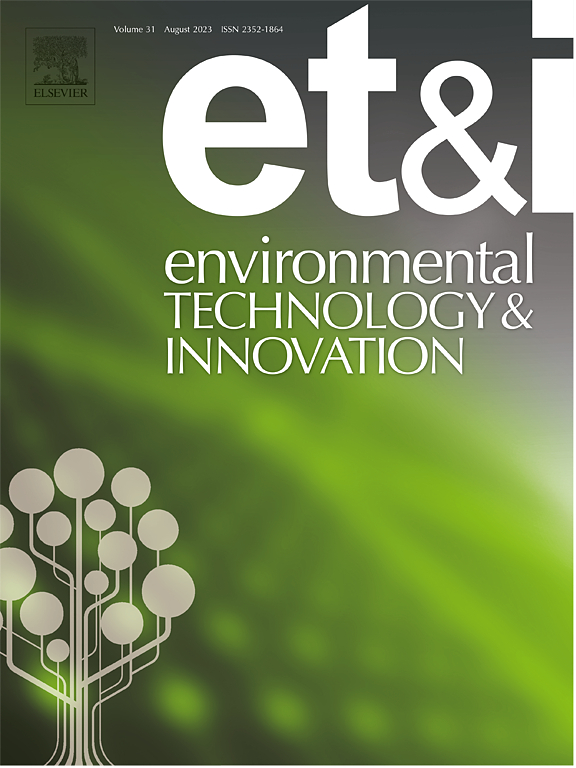不同海藻酸盐混合基质固定化小球藻藻修复水产养殖废水的比较研究
IF 6.7
2区 环境科学与生态学
Q1 BIOTECHNOLOGY & APPLIED MICROBIOLOGY
引用次数: 0
摘要
水产养殖废水的管理提出了显著的环境挑战,需要有效的补救技术。本研究通过固定化小球藻,探索了利用天然衍生的固定化材料(淀粉、纤维素和细菌纤维素)进行基于微藻的藻修复,并提供了传统合成基质的环保替代品。本研究旨在评价最佳固定化载体,并评价固定化微藻去除水产养殖中化学需氧量(COD)、生物需氧量(BOD)和总氮(TN)的效果,以及生物量和脂质生产力。本研究以淀粉、纤维素和细菌纤维素为载体,对微藻进行固定化处理,在处理12 d内进行了藻修复效果评价。结果表明,固定化小球藻可将水体COD从96降至10.25 (mg/L), BOD从24降至3.4 (mg/L), TN从43降至4 (mg/L),具有较高的藻修复效果。纤维素珠的脂质含量最高(26.76 %)。而细菌-纤维素载体的生物量产量为39.38 mg/L,脂质产量为38.33 mg/L/d,这表明固定化小球藻在细菌-纤维素珠中可以有效地处理水产养殖废水和生物燃料生产。本研究通过详细分析固定化微藻在水产养殖系统中用于可持续废物管理的利用,对环境生物技术领域作出了重大贡献。本文章由计算机程序翻译,如有差异,请以英文原文为准。
A Comparative phycoremediation study of aquaculture wastewater treatment by Chlorella sp. immobilized in different hybrid-alginate matrices
The management of aquaculture wastewater presents notable environmental challenges, requiring efficient remediation techniques. This study explores the use of naturally derived immobilization materials (starch, cellulose, and bacterial cellulose) for microalgal-based phycoremediation, by utilising immobilized Chlorella sp. and offers an eco-friendly alternative to conventional synthetic matrices. The study aimed to evaluate the best immobilized carrier, and to assess the effectiveness of immobilized microalgae in removing nutrients such as chemical oxygen demand (COD), biological oxygen demand (BOD), and total nitrogen (TN) from aquaculture, along with biomass and lipid productivity. In this study, the phycoremediation using microalgae immobilized with different carrier including starch, cellulose and bacterial cellulose were evaluated within 12 days treatment. The results indicated that Chlorella sp. immobilized in starch beads demonstrated higher phycoremediation efficiency by reducing the level of COD from 96 to 10.25 (mg/L), and BOD from 24 to 3.4 (mg/L), and TN level from 43 to 4 (mg/L). Cellulose beads also showed the highest lipid content (26.76 %). While bacterial-cellulose carrier showed higher biomass production at 39.38 mg/L and lipid productivity 38.33 mg/L/day This suggests that immobilized Chlorella sp. in bacterial-cellulose beads can effectively treat aquaculture wastewater and biofuel production. This study makes a significant contribution to the field of environmental biotechnology by providing a detailed analysis of the utilization of immobilized microalgae for sustainable waste management in aquaculture systems.
求助全文
通过发布文献求助,成功后即可免费获取论文全文。
去求助
来源期刊

Environmental Technology & Innovation
Environmental Science-General Environmental Science
CiteScore
14.00
自引率
4.20%
发文量
435
审稿时长
74 days
期刊介绍:
Environmental Technology & Innovation adopts a challenge-oriented approach to solutions by integrating natural sciences to promote a sustainable future. The journal aims to foster the creation and development of innovative products, technologies, and ideas that enhance the environment, with impacts across soil, air, water, and food in rural and urban areas.
As a platform for disseminating scientific evidence for environmental protection and sustainable development, the journal emphasizes fundamental science, methodologies, tools, techniques, and policy considerations. It emphasizes the importance of science and technology in environmental benefits, including smarter, cleaner technologies for environmental protection, more efficient resource processing methods, and the evidence supporting their effectiveness.
 求助内容:
求助内容: 应助结果提醒方式:
应助结果提醒方式:


